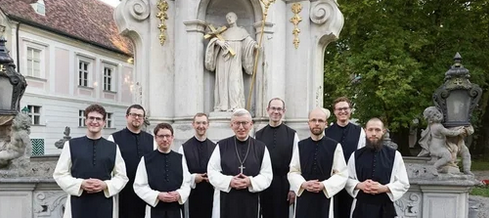Heiligenkreuz, first target of the new team at the head of the Dicastery for Consecrated Life
From the media outlet Silere non possum, a clear warning is issued: the ban against traditional monasteries has begun. In a recent publication, the media outlet reveals that the Dicastery for Institutes of Consecrated Life and Societies of Apostolic Life has ordered an apostolic visit to the historic Cistercian abbey of Heiligenkreuz, in Austria, one of the most flourishing monastic communities in Europe.
The decision bears the signature of the new team that directs the Dicastery: Sister Simona Brambilla, appointed prefect in January, and Sister Tiziana Merletti, secretary since May. Both religious, trained in a clearly progressive ideological climate, seem willing to act firmly against those communities that do not conform to their way of understanding religious life.
Traditional monasteries that thrive, in the crosshairs
Heiligenkreuz, an abbey that combines fidelity to tradition, rich liturgy, and vibrant community life, has achieved something that many others have not: attracting numerous vocations. And it is not an isolated case. Within various monastic orders, a growing trend is observed: many abbeys, enjoying the legal autonomy recognized by Canon Law, are choosing to live their charism in a way that is more faithful to their foundational rules, that is, with a more traditional interpretation. This renewed fervor not only attracts vocations, but, in many cases, revitalizes the spiritual life of their surroundings.
But this success seems to have aroused misgivings in ecclesiastical sectors unwilling to allow alternative models to a still dominant progressivism. This apostolic visit would not respond to real internal problems, but would be an action motivated by ideological criteria and by internal pressures within the same Cistercian order, headed by Abbot General Mauro Giuseppe Lepori.
A strategy of attrition against what works
Lepori, identified with a line more accommodating to the new times and close to the Communion and Liberation movement, would have targeted Heiligenkreuz and other similar abbeys for not following his guidelines. Far from the neutrality that should characterize his function, he has promoted a process of scrutiny that, rather than seeking the good of the communities, seems aimed at punishing their success.
Behind many of these apostolic visits there is little more than rumors, unfounded criticisms, or anonymous reports. The formula is simple: when a traditional community grows, someone – whether for ideology or personal jealousy – launches more or less veiled accusations. That is enough to open a process that can end in external intervention or even the dismissal of the legitimately elected abbot.
What is happening in Heiligenkreuz is a symptom of something broader: a climate of institutional hostility towards traditional forms of religious life, especially when they thrive. And the apostolic visit is not an exception, but a first visible step in a policy that could intensify in the coming months.
If the flourishing of monasteries faithful to the Rule and tradition is punished, what kind of renewal is intended for consecrated life? The question remains open, while in Austria a praying community awaits the arrival of the inspectors sent from Rome.
https://infovaticana.com/2025/06/16/la-prefecta-brambilla-lanza-su-primer-movimiento-contra-las-abadias-tradicionales/
